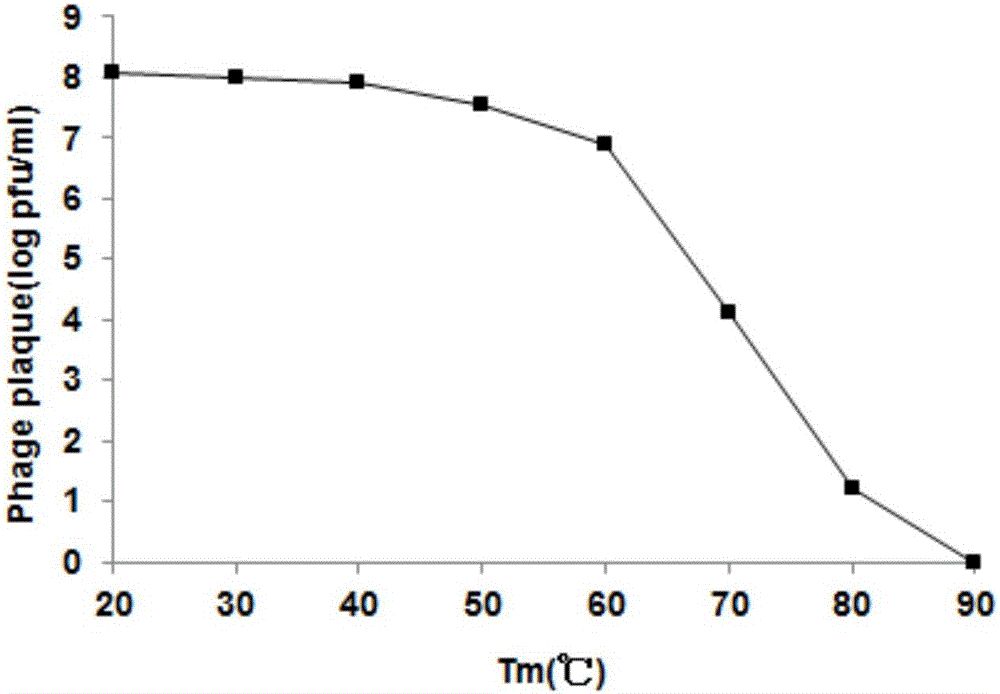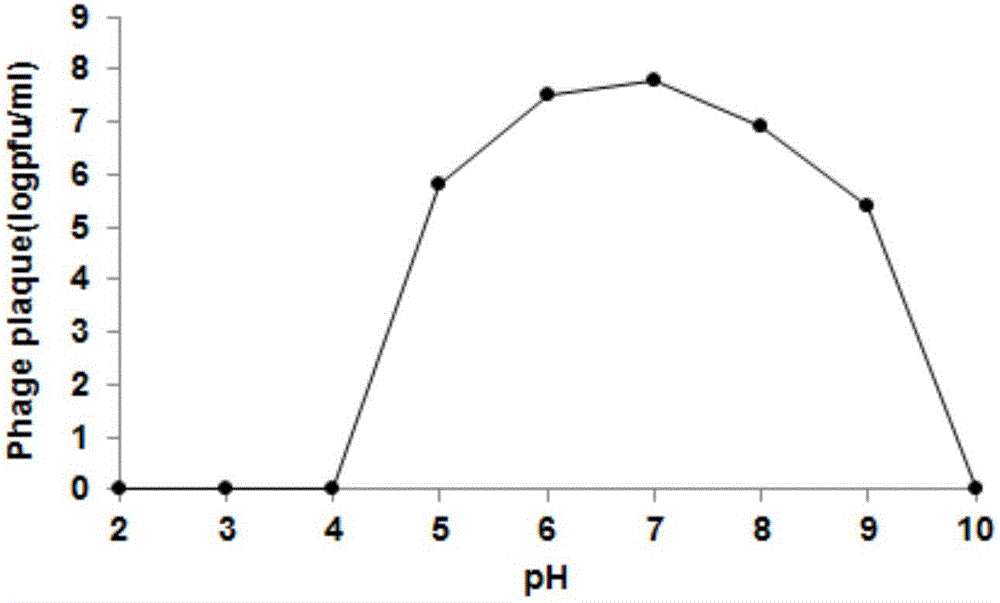Enterohaemorrhagic escherichia coli phage and application thereof
A technology for enterohemorrhagic Escherichia coli, which is applied in the field of enterohemorrhagic Escherichia coli phage and its application, can solve problems such as inability to effectively control transmission, and achieve the effect of preventing survival and reproduction, pollution and overgrowth
- Summary
- Abstract
- Description
- Claims
- Application Information
AI Technical Summary
Problems solved by technology
Method used
Image
Examples
Embodiment 1
[0021] Embodiment 1, the separation and preparation of phage
[0022] The sample of the present invention is collected from pig farm cleaning site sewage, filtered through double-layer filter paper, 5000 × g.min -1 Centrifuge for 10 min, and filter the supernatant through a 0.22 μm filter membrane.
[0023] Take 50ml of the filtered supernatant, add 2ml of phage host bacteria EHEC O157:H7 overnight culture, add 20ml of LB medium, incubate at room temperature for 30min, and then place it at 37°C for 12-16h. The next day, take the above-mentioned culture and wash it at 14000×g.min -1 Centrifuge for 30min, take the supernatant; 14000×g.min -1 Centrifuge again for 20 min, take the supernatant and add 0.1% chloroform to form a phage stock solution.
[0024] Take 0.1ml of bacteriophage stock solution, carry out 10-fold dilution, take 10 2 、10 4 and 10 6 Mix 0.1ml each of the dilution solution with 0.1ml of the overnight cultured host bacterial solution. After 15 minutes at roo...
Embodiment 2
[0025] Embodiment 2, purification and transmission electron microscope analysis of phage
[0026] Get 2ml of freshly cultivated host bacteria, centrifuge, resuspend in 0.4ml LB medium, add 0.1ml phage (according to the ratio of 1:1, 1:10 and 1:100 of the single phage culture obtained in Example 1 and the host bacteria respectively) Proportion). Add maltose (0.2%), MgSO 4 (10mM), incubate at 37°C for 20min to make the phage particles adsorb to the host bacteria; add 100ml LB liquid medium containing maltose (0.2%), MgSO 4 (10mM), shake at 37°C for 9-12h; add 0.1ml chloroform, continue shaking at 37°C for 10-20min to obtain a lysate.
[0027] Transfer the lysate to a centrifuge tube and centrifuge at 8000×g.min -1 , to remove bacterial fragments, take the supernatant; add RNase A, DNase I to 1 μg / ml, incubate at 37°C for 30 minutes; add 9.3g PEG 8000, 5.8g NaCl, shake well until dissolved, ice-bath for 1h or overnight at 4°C; 4 Centrifuge at 10000×g.min -1 20min, remove th...
Embodiment 3
[0029] Embodiment 3, the influence of temperature and pH on phage stability
[0030] Take 0.1ml 1×10 respectively 8 pfu / ml of purified phage was reacted in a water bath at 40°C to 90°C for 1 hour, and the titer was measured after the sample was cooled in an ice bath; peptone water with pH 2.0 to 9.0 and 2×10 8 Pfu / ml purified phages were mixed in equal amounts, and the potency was measured after 2 hours in a water bath at 37°C.
[0031] The results show that if figure 2 As shown, after the phage was treated at 20°C to 50°C for 1 hour, its activity did not change significantly; at 60°C for 1 hour, the activity decreased; after acting at 70°C, the titer decreased to less than 50% of the initial titer; at 90°C , almost inactivated.
[0032] The results after the phage were treated with different pH image 3 , the titers of phages were all at 10 after pH6.0~8.0 8 pfu / ml, its activity did not change significantly; when the pH was 6.0 and 9.0, respectively, its titer decreased t...
PUM
 Login to View More
Login to View More Abstract
Description
Claims
Application Information
 Login to View More
Login to View More - R&D
- Intellectual Property
- Life Sciences
- Materials
- Tech Scout
- Unparalleled Data Quality
- Higher Quality Content
- 60% Fewer Hallucinations
Browse by: Latest US Patents, China's latest patents, Technical Efficacy Thesaurus, Application Domain, Technology Topic, Popular Technical Reports.
© 2025 PatSnap. All rights reserved.Legal|Privacy policy|Modern Slavery Act Transparency Statement|Sitemap|About US| Contact US: help@patsnap.com



